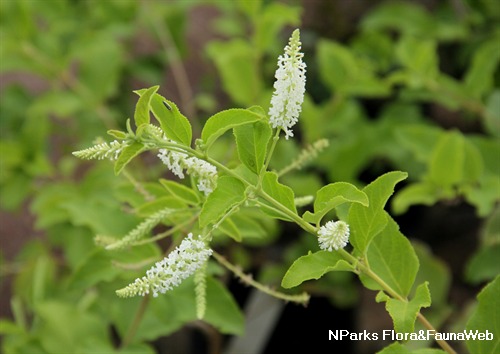.jpg)
Back
Aloysia virgata (Ruiz & Pav.) Juss.
| Family Name: | Verbenaceae |
| Synonyms: | Aloysia urticoides Cham., Verbena virgata Ruiz & Pav. |
| Common Name: | Sweet Almond Verbena, White Almond Bush, Incense Bush, Tree Verbena |
Name
Classifications and Characteristics
| Plant Division | Angiosperms (Flowering Seed Plants) (Dicotyledon) |
|---|---|
| Plant Growth Form | Shrub |
| Lifespan (in Singapore) | Perennial |
| Mode of Nutrition | Autotrophic |
| Plant Shape | Leggy |
| Maximum Height | 3 m to 3.6 m |
| Maximum Plant Spread / Crown Width | 2.4 m to 3 m |
Biogeography
| Native Distribution | Argentina |
|---|---|
| Native Habitat | Terrestrial |
| Preferred Climate Zone | Tropical, Sub-Tropical / Monsoonal |
| Local Conservation Status | Non-native (Horticultural / Cultivated Only) |
Description and Ethnobotany
| Growth Form | Evergreen to deciduous, woody shrub with weeping growth habit. |
|---|---|
| Foliage | Leaves are elliptic with a toothed leaf margin, and arranged oppositely along the stems. Leaf apex is acute while base is acute to rounded. Leaf texture is tomentose. |
| Stems | Multi-stemmed, stiff, four-sided, densely hairy at first and develop lenticels later on. |
| Flowers | Small, white flowers are bell-shaped to salver-shaped with 4 ruffled lobes and have a sweet, fruity fragrance. This species is dioecious with male and female flowers occuring on different plants. They are arranged in drooping spike inflorescences (20 cm long) that are located at the stem tips or leaf axils. |
| Fruit | Dry, dehiscent fruits are known as capsules. They are round and brown. |
| Habitat | Occurs in open woodlands and forest margins. |
| Similar | The flowers of this species are similar to those of Buddleja asiatica (synonym: Buddleia asiatica). However, the leaves of Aloysia virgata are wider and held horizontal, while those of Buddleja asiatica are narrow, sharply pointed and tend to droop. |
| Cultivation | This species should be planted in loamy, well-draining soil (pH 6.5 - 7.5). It is tolerant of nutritient poor and alkaline soils. Plants should be pruned after flowering, because flowers develop on the new growth. Propagate by seed, stem cuttings and air layering. Seeds should be stratified for 4 weeks at 4°C and sown on the soil surface. They will germinate within 3 to 4 weeks. Seeds tend to be quite vulnerable, so avoid overwatering to prevent damping off. |
| Etymology | Genus Aloysia commemorates Queen Maria Louisa (1751 - 1819), wife of King Charles IV of Spain. Species virgata means with straight slender twigs and refers to the growth habit of the plant. |
| Ethnobotanical Uses | Medicinal: It can be used to induce abortion. The juice extracted from leaves may be applied externally to treat skin diseases. Others: Food: The roots can be dried and powdered and used in preparation of a fermented liquor. Other: The flowers are used as an ingredient in perfumes. The wood can be used for making walking sticks. |
Landscaping Features
| Landscaping | The plant is cultivated for its long blooming and fragrant flowers. |
|---|---|
| Desirable Plant Features | Ornamental Flowers, Fragrant (Flowers) |
| Landscape Uses | Parks & Gardens, Small Gardens, Container Planting |
| Thematic Landscaping | Butterfly Garden, Fragrant / Aromatherapy Garden |
Fauna, Pollination and Dispersal
| Fauna Pollination Dispersal Associated Fauna | Butterfly-Attracting (Flower Nectar), Bird-Attracting |
|---|---|
| Pollination Method(s) | Biotic (Fauna) (Insects (Butterfly, Moth), Insects (Bee), Vertebrates (Bird)) |
Plant Care and Propagation
| Light Preference | Full Sun |
|---|---|
| Water Preference | Moderate Water |
| Plant Growth Rate | Moderate |
| Rootzone Tolerance | Drought Tolerant, Moist Soils, Well-Drained Soils |
| Propagation Method | Stem Cutting (Softwood), Air-Layering |
Foliar
| Foliage Retention | Evergreen |
|---|---|
| Mature Foliage Colour(s) | Green |
| Mature Foliage Texture(s) | Velvety / Furry / Tomentose, Rough |
| Foliar Type | Simple / Unifoliate |
| Foliar Arrangement Along Stem | Opposite |
| Foliar Attachment to Stem | Petiolate |
| Foliar Shape(s) | Non-Palm Foliage (Elliptical) |
| Foliar Margin | Serrate / Toothed |
| Foliar Apex - Tip | Acute |
| Foliar Base | Acute, Rounded / Obtuse |
| Leaf Area Index (LAI) for Green Plot Ratio | 4.5 (Shrub & Groundcover - Dicot) |
Floral (Angiosperm)
| Flower & Plant Sexuality | Unisexual Flowers |
| Flower Colour(s) | White |
|---|---|
| Flower Grouping | Cluster / Inflorescence |
| Flower Location | Axillary |
| Individual Flower Shape | Campaulate / Bell-shaped, Salverform |
| Inflorescence Type | Spike |
| Flowering Period | Free-Flowering |
Image Repository
Others
| Master ID | 439 |
|---|---|
| Species ID | 1735 |
| Flora Disclaimer | The information in this website has been compiled from reliable sources, such as reference works on medicinal plants. It is not a substitute for medical advice or treatment and NParks does not purport to provide any medical advice. Readers should always consult his/her physician before using or consuming a plant for medicinal purposes. |






